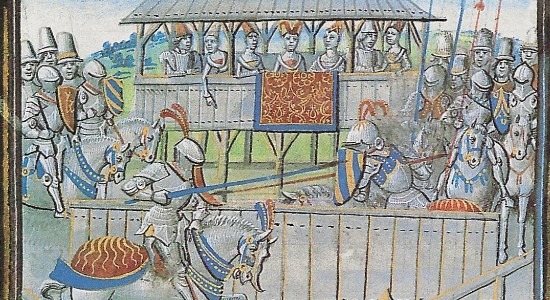MedievalReporter.com
Covering history's most marvelous millennium
Join our newsletter!

Covering history's most marvelous millennium
Covering history's most marvelous millennium

The second estate of medieval society, the bellatores or “those who fight”, were a clearly privileged class. Whereas the third estate (the laboratores) had to work for a living, and the first estate (the oratores) focused on faith, the bellatores ruled. They created the political system of the European Middle Ages – at first defined by blood and kin, later well-regulated and codified into law.
This is the second installment in our Three Estates saga, covering the bellatores. More interested in prelates and prayer? Then check out our first episode:
Are you interested in the common folk instead? Take a look at our third episode:
The roots of the medieval social orders sprouted under the shade of a dying empire. As the Western Roman Empire collapsed, people departed from towns and cities. The size of communities diminished, but they were better spread out; essentially, population density declined, but true population size may have increased. Outside the Mediterranean basin, by the year 450 CE most of Europe’s population was living in rural homesteads, focused on sustenance agriculture.
Furthermore, the 5th century saw the near-universal penetration of Germanic peoples into former Roman territories. Sometimes, these intrepid invaders resettled en-masse, as they did in England and Northern France, establishing Anglo-Saxon and Frankish kingdoms. Elsewhere, they installed themselves as ruling elites, presiding over locals who more or less just accepted what had befallen them, as was the case in Visigothic Spain, where people of Germanic ancestry probably never exceeded 2% of the population.
Yet even then, the Germanic influence profoundly changed medieval society. For starters, Germanic societies were much more practical, as nearly everyone worked the land – whether farming or rearing cattle for wool and meat. Only a minute part of the people took on special religious or craftsmanship roles. Physically fit men would also fight when needed, but insofar as sources tell us, the Germanic way of warfare never went beyond bands of varying sizes led by important chieftains.

– advertisement –
– article continues below –
The need for agricultural manpower meant that only a few men could fully dedicate themselves to military life, and they usually did so in service to great chieftains. They were the housecarls, or “the household’s freemen”, suggesting that early Germanic peoples practiced some sort of forced labor system too. Their name derives from the Germanic terms for “house” and “freeman” – Karl. Germanic societies were roughly divided into three stratified segments, which in many ways resembled the later orders of medieval society, but fragmentary evidence also supports that within these main groups other classifications existed.
Sometimes one jarl managed to subdue, intimidate or simply kill off the other jarls. He would then rise to the sovereign rank of konungr – from whence comes the word “king”. Early medieval kingship was highly personal and rested on the ability of the konungr to control the other jarls. As a result, the “kingdom” usually splintered into separate factions after (or even before) his death. The legalist concept of hereditary rule would only come around later in the Middle Ages.
To sum up, the housecarls and jarls made up the second estate, the bellatores. A king, when there was one, would naturally also fall within this order of society.

The last ingredient of medieval society was organized religion. The Romans had an elaborate pantheon and worshipping system, but it was slowly superseded by what would become the Catholic Church during the 4th and 5th centuries CE. The Romans, however, had never bothered to convert to their creed any of the many peoples they conquered; the early Church’s attitude was the complete opposite. Evangelizing missions sprung and spread throughout Europe as the Empire died.
The Catholic Church quickly began to fill the voids in education left unattended by the declining Roman Empire. Above all, over time the Church managed to become the new centralized social authority. As such, the missions were quite successful in attracting the invading pagan chieftains. While the Goths had been practicing Christianity for some time, the first great Germanic king to convert to Christianity was Clovis I of the Franks, on Christmas Day in 508, thus sanctioning Clovis’s political authority through religion.
A societal alliance had thus been forged, linking the fates of crown and church, and combining the religious authority of the clergy (the oratores) with the temporal prowess of the aristocracy (the bellatores). Together, the first and second estate would rule over most of the third (the laboratores) well into the Modern Era. One legitimized the other and so created a societal framework that would become the foundation of medieval Europe.
Early medieval kingdoms were only as strong as their monarch, which explains why for centuries the concept of a capital was all but non-existent. These early kings, whether Gothic or Frankish, exercised rule over their folk, rather than a delimited geographic area.
To rule, these kings traveled extensively across their realms, and essentially deputized their kinsmen or allies to rule in their absence. To prevent rebellion, kings bought their undying loyalty by granting them a fief – a large tract of land that could amply provide for all its inhabitants. The man providing the land was the lord, and the one receiving it was the vassal – although this terminology would only really receive institutional weight after the Middle Ages had ended.
The lord had the sacred obligation of protecting his vassals, and the vassals were to perform military duties for their lord, albeit other ways of serving him could be exacted. For example, the small province of Andorra was to provide, in the early 10th century, two hams, forty loaves of bread, wheels of cheese, and other miscellaneous goods, to the County of Cataluña, as part of the feudal relation between its rulers. This relationship, reinforced by a rite of homage paid by the vassal to his lord, could be replicated several times over, thus making a vassal someone else’s lord. In early medieval continental Europe, this basically created multiple autonomous provinces with their kings – if there even was one – as mostly symbolic figureheads.

One dynasty changed all of this: the Carolingians. For centuries, Charles the Great has been lauded as the Father of Europe, with France and Germany unsuccessfully disputing his national identity throughout the centuries. While the moniker “Father of Europe” may elicit nationalist undertones, there is some truth to it. Under Charlemagne’s forty-eight years of rule over the Franks, he managed to model the political makeup of Europe for centuries to come, integrating the three components of the Catholic medieval society.
While at first glance it seems as though Charlemagne was a proto-absolutist ruler, the reality is that he relied on his vassals as much as they depended on him to justify their socio-economic status, which stimulated them to accompany the emperor on his never-ending campaigns. Undoubtedly another great motivation for them to follow him was the promise of vast lands and labor (thralls!) to work them with, as well as cash bounties.
In many ways, Charlemagne was the template that many European kings would model themselves after; lord of lords, and protector of the Church. Theoretically, all sorts of excuses legitimized that a certain group of people should rule, from legendary genealogies to divine appointment. In practice, however, it was often the man with the biggest army and best leadership who would ascend the throne during the Early Middle Ages. The official claims did help, but ultimately it was martial prowess that created the early medieval elites, and that very same warmongering attitude narrowed them down and led to the consolidation of kingdoms.
Charles Martel was one such early example, defining authority over his kinsmen after soundly defeating an Umayyad army at Poitiers in 732, and establishing a kingdom stronger than any of his ancestors. Across the English Channel, Alfred of Wessex achieved a similar feat when in the 880s he expelled one of the largest Viking expeditions ever. Later, in the 11th century, it was through military might that the fate of England was decided, when – in less than a month – two battles were fought over the kingdom’s fate.
These warlords and generals were the bellatores, from the Latin for “those who fight”. Their main duties were combat and command. To sustain themselves, they held land, but the bellatores were not meant to work the estates provided to them by their lords. Instead, members of the order of the bellatores were taught the arts of war, which was expected of them regardless of how rich or famous they became.

Firstborns were also taught certain notions of ruling and justice, which was the closest to actual work that lords were expected to do. In a decentralized society as was Catholic Europe, enforcing the king’s law was left to the vassals. Dispensation of secular justice was left to lords, which could include anything from land disputes to heinous crimes.
Part of the argument as to why the bellatores’ military prowess was one of God’s blessings was that it would serve to order earthly matters; wisdom was another one. Indeed, lords were almost universally literate, well-instructed people, versed in poetry and arithmetic; Charlemagne himself ensured that his children received the best education in Europe at the time, and any lord able to afford it would follow his lead.
– advertisement –
– article continues below –
Not all bellatores were created equal. The tangled networks of feudalism had many implications for the relations between bellatores. Some of the duties owed to a lord were in kind or cash payments, but fundamentally, they were military in nature. In general, this obligation meant that a vassal would equip a varying number of professional men-at-arms at his own expense to provide for his lord’s time on campaign. These men bore the name servus milites, technically meaning “military servants”. (The word “knight” comes from the Old English cniht or Germanic Knecht, meaning “servant”.) Despite the appellative, these soldiers were not commoners; they were part of the social elite, and indeed the core of the bellatores.
Central to the knight was his horse, and here controversy is nearly endless. For decades now, historians have argued about the importance of an invention in the early first millennium CE in distant China that entered Europe in the Early Middle Ages: stirrups. Their history is not entirely known, but they may have reached the Balkans through contact with the Khazars in the late 7th century CE, and were readily adopted by the Bulgars. Some historians have postulated that it was thanks to stirrups that heavy cavalry arose as a more reliable military resource in the Middle Ages, because these provide better handling of the horse when carrying heavier arms and armor. Others have countered by saying that even before stirrups were invented, heavy cavalry was in extensive use, especially in Persia and the Byzantine world, where equine husbandry had become essentially an arms race between those two powers, to get a bigger, heavier, faster, and more resilient steed.
At any rate, the welcoming of stirrups by the Carolingians, and larger horse breeds developed in the Byzantine and Persian Empires made for a massive force multiplier quickly adopted by continental Europe’s warrior order. (Prior to the Carolingians, save for a few examples, European warriors fought on foot.) Thus, the professional medieval soldiery was intrinsically tied with horsemanship, even beyond military service; to this day, the traditional, romanticized code of conduct expected of men is known as “chivalry” – which derives from the French word for horse, cheval. The variations are plenty, considering the plethora of dialects spoken in Europe back then, but when simplifying to their modern analogs, all ultimately mean “horseman”:
Apart from the French association with a code of conduct often portrayed in medieval literature, the mentioned words refer to other attitudes associated with knighthood: in Spanish, caballero also means “gentleman”, hinting that this is meant to be a respectable man, whereas in Italian, cavaliere means reckless, or bold – a not uncommon characteristic found in literature concerning the lives of impetuous medieval knights.

The world of knighthood is deserving of an article of its own, as nuance within abounded. It was full of contradictions, chief among them being that knighthood was not necessarily a desirable position for most bellatores, as most of the service that knights usually performed was unpaid, and the lands held by knights seldom allowed them to afford to live the ostentatious lifestyles of great lords – in fact, given the cost of arms, armor, horses and the maintenance of it all, it could almost be considered a burden. And yet, knighthood offered significant social mobility – thus making it attractive to those outside the fighting order of society – as knighthood could be attained through bravery on the battlefield. The dedicated – and granted, lucky – knight could secure himself a position near a magnate, and become a man of moderate wealth. By the 14th century, industrious and wealthy knights would actually pay a fee of sorts, the scutage, when summoned for campaign, instead of going to war.
The profile of the average knight, between the 10th and early 12th centuries was of a young man, usually the second or younger son of any nobleman; laws generally favored inheritance for firstborns, which meant that knights usually just had enough to get by, and at times not even sufficient money to cover their professional expenses. William Marshall, who would become regent of England for Henry III in the 13th century, was in his youth once left horseless during a tourney, and his tutor had to provide him with a mount for him to finish the competition. In time, William Marshall came to own Chepstow Castle, one of the best-preserved in England to this day.
We have just mentioned two aspects of the life of the bellatores that were central to them: castles and tournaments.
The castle performed a dual residential and military function for the lord, and it was common for powerful lords to have several castles – of varying sizes and quality, but castles nonetheless. Within the castle dwelt the lord and his familia, which while naturally meaning his blood family, also included trustworthy servants, and household knights – another word for them being retainers. Proper lords took significant pride in their castles and decorated them extensively, filling the interior rooms with frescoes, wood carvings, curtains, and elaborate fireplaces.
Tournaments, on the other hand, were meant to emulate war. While they shared some aspects with the practice of hunting, the tournament rose from a necessity to professionalize warfare; contrary to the romanticized images knights promoted to exalt their battlefield deeds, they often fought in compact units to maximize their strength, and to be battle-efficient, constant training was required. Early tourneys were melee fights lasting perhaps a few days in which units of knights fought in “teams”.
Likewise, contrary to the popular belief promoted by Hollywood blockbusters, knights seldom charged all at once, but rather organized charges in small units of ten to fifteen men, called conrois. These were, after all, professional soldiers, and it was in the interest of the vassal supplying them to his lord’s army to keep most of them alive – if only because of the cost of equipping and preparing them to war. At the Battle of Hastings, for example, Norman knights fully clad in chainmail, wielding spears and swords, charged in groups. One of these units successfully broke the Anglo-Saxon shield wall, where four knights dealt the final blow to king Harold Godwinson.

Knightly recreational activity revolved around feasting. It was a social networking and boasting opportunity, as was dressing fashionably, regardless of the period. No reputable lord would be left without entertainment, so seldom would a lord host anyone without a poet, a jongleur, or a musician at hand to set the mood. Moreover, it was in any lord’s interest to show how pious he was, often meaning donations of cash or land to their local church, monastery, or cathedral. All in all, the lord was concerned with a lifestyle that was not only luxurious for the sake of comfort, but also outright ostentatious.
Towards the 13th century, urban merchants had started to amass veritable fortunes providing the bellatores with spices, gems, furs, silks, among others. They had become rich enough to financially challenge the nobility, which often found itself deep in the pockets of the emerging bankers. This is why noblemen put up these flamboyant shows of wealth, to socially distance themselves from burghers, and emphasize the theoretical privileges they had – sometimes enacting sumptuary laws that forbade the burghers from indulging in the same pleasures.
– advertisement –
– article continues below –
The rise of burghers in Northern Italy and the Low Countries challenged the social authority of the traditional landed nobility, chiefly because the latter could seldom financially compete with the urban merchants and bankers. Money, after all, makes the world go round.
But the status of the bellatores remained a lofty one, if in law at least. They continued to enjoy legal privileges in matters of taxation, as well as the tributes that the crown or other lords could exact on them, and even as late as present-day England, continued to own considerable amounts of land.
And yet, never did the bellatores renounce their martial calling. In Spain, the younger sons of noble families, rich and disgraced alike, called hidalgos, formed the ranks of the royal tercios in the 16th and 17th centuries – a fierce professional, proto-standing army at the disposition of the kings of Spain. They also led expeditions into the New World, with financing coming from Italian banks, often secured on nothing more than the pedigree of their families. Elsewhere in Europe, throughout the 17th and 18th centuries, the sons of nobles tended to find themselves as officers in the navies and armies that were springing up left and right, although usually buying their place in the officer class, rather than earning it in action. Even as recently as the 21st century, the British princes William and Harry have served combat missions on behalf of the British armed forces in the Middle East, living up to a millennium of military tradition embedded into the social order they were born into.
The old orders of society may have mostly faded, but if the royals’ example serves to illustrate anything, it’s that old habits die hard.
Comments are closed.
Massive thumb up for this blog post!
We concur. 😉 Thanks!
It’s arduous to find knowledgeable people on this subject, but you sound like you know what you’re speaking about! Thanks
Thank you, Lennon! We try our best. 🙂
Hey very cool site!! Man .. Beautiful .. Amazing ..
Thanks so much, Verdine!